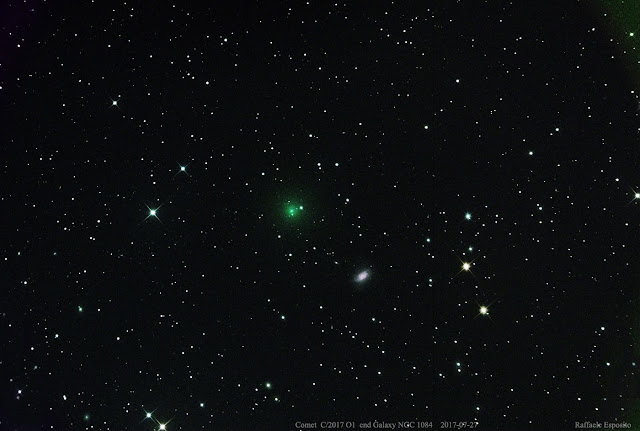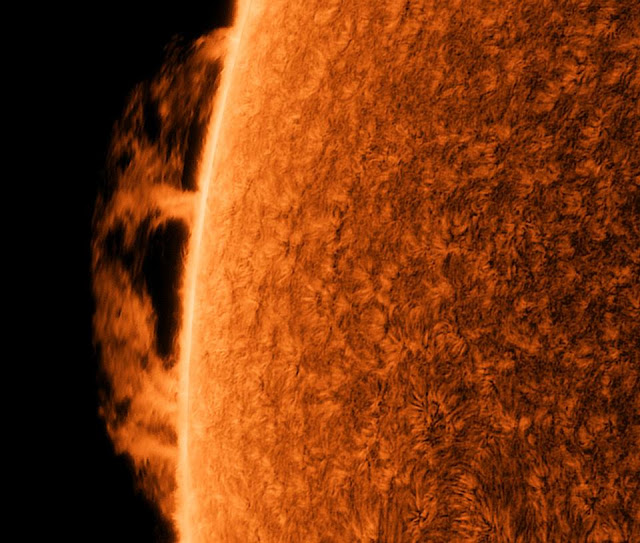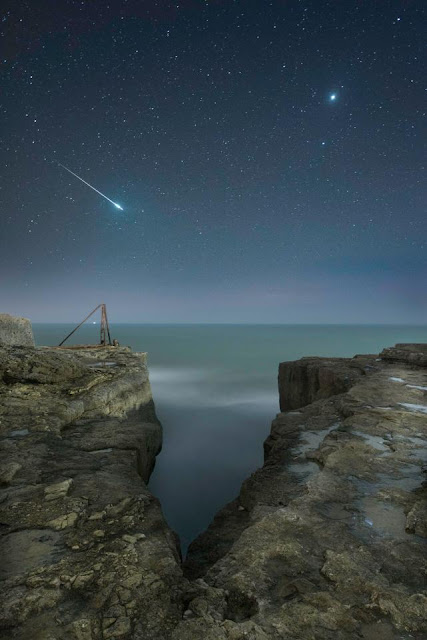THE SHOW IS AVAILABLE IN MANY LANGUAGES FOR FREE
I like astronomy, archaeology, photography, music and drinking a lot of tea. I hate politics. Something that annoys me: that I shall not respect the permanence, and to take me by what I'm not. The best sign: VIRGO. The worst: the health. The best: adapt and know how to get ahead. FIRST BLOG: esplaobs.blogspot.com, SECOND BLOG: esplaobs02.blogspot.com, RETRO BLOG: esplaobs01.blogspot.com, YOUTUBE CHANNELS: esplaobs, esplaobs. ext02. Instagram: esplaobsrosario. Welcome to my BLOGs !
Sunday, July 30, 2017
A TOTAL ECLIPSE AT THE END OF THE WORLD Image Credit & Copyright: Fred Bruenjes (moonglow.net)
Would you go to the end of the world to see a total eclipse of the Sun? If you did, would you be surprised to find someone else there already? In 2003, the Sun, the Moon, Antarctica, and two photographers all lined up in Antarctica during an unusual total solar eclipse. Even given the extreme location, a group of enthusiastic eclipse chasers ventured near the bottom of the world to experience the surreal momentary disappearance of the Sun behind the Moon. One of the treasures collected was the featured picture -- a composite of four separate images digitally combined to realistically simulate how the adaptive human eye saw the eclipse. As the image was taken, both the Moon and the Sun peeked together over an Antarctic ridge. In the sudden darkness, the magnificent corona of the Sun became visible around the Moon. Quite by accident, another photographer was caught in one of the images checking his video camera. Visible to his left are an equipment bag and a collapsible chair. A more easily visible solar eclipse will occur in about three weeks and be visible from the USA.
COMET C/2017 O1 ASASSN Taken by José J. Chambó on July 28, 2017 @ Valencia, Spain
New comet C/2017 O1 ASASSN imaged on July 28th 2017, was discovered during an abrupt increase of brightness until the magnitude 10 at present. As seen in this image has developed a green gassy coma of diatomic carbon, with an appearent size of 10 arcminutes. This comet can reach a maximum brightness around 7th magnitude on next october when be observable from northern hemisphere passing near celestial zenit. There are some galaxies in this field, at right NGC 1084 and at bottom-left NGC 1110 edgeways.
GSO 8 f/3.7 & Atik 383L+ (L:5×240s Bin1 + RGB:3x120s Bin2) from Hoya Redonda, Valencia (Spain)
NIGHT SKY Taken by Mahyar Moradi Chafi on July 29, 2017 @ Chaf, Langarood, Guilan, Iran
Its good to teach something you know to some one who wants to know , and the best feeling is that your love is your student and the subject is the Wonders of the night sky.
MUSICA FUNCION DE PLANETARIO ROSARIO " PRESAGIOS DEL CIELO " ( 1995 )
FUNCIÓN PLANETARIO CIUDAD DE ROSARIO
"PRESAGIOS DEL CIELO " ( 1995 )
Función escrita por Dr. Carlos F. Sosa con notas de Alberto Draniczareck
Selección Musical: Esmeralda Sosa
Selección Musical: Esmeralda Sosa
LISTADO DE TEMAS
DAVID ARKENSTONE " ANOTHER STAR IN THE SKY " Pool of Radiance
DAVID ARKENSTONE "PRECIOUS WATERS" Stormlight
TANGERINE DREAM " CANYON DREAMS " Shadow Flyer
MAURICE RAVEL Bolero
DAVID ARKENSTONE " IN THE WAKE OF THE WIND " Papillon (On the Wings of the Butterfly)
VANGELIS " DIRECT " The Motion of Stars
STEWART COPELAND " RAPA NUI SOUNDTRACK" Topple Moai
DAVID ARKENSTONE " QUEST OF THE DREAM WARRIOR " The Journey Begins- Kayla's Ride
ERICH KUNZEL & CINCINATTI POPS ORCHESTRA " STAR TRACKS II " DON DORSEY Dimensions
VANGELIS " DIRECT " Metallic Rain
JOHN WILLIAMS " JURASSIK PARK " Opening Titles
DEEP FOREST " BOHEME " Deep Folk Song
RANDY EDELMAN " COME SEE THE PARADISE " Fire in the Brooklyn Theater
BASIL POLEDOURIS " LASSIE " SOUNDTRACK Return / Reunion
( portada del CD que usábamos para reproducir la función )
.. una función que quedara marcada en la Historia del Planetario Ciudad de Rosario, plagada de historias, Efectos Especiales elaborados especialmente para esta función y con un final que emocionaba tanto al publico que muchos salían llorando ..
.. INOLVIDABLE FUNCIÓN ! ..
Friday, July 28, 2017
COMET C/2017 O1 Taken by Raffaele Esposito on July 27, 2017 @ ITelescope Siding Spring Australia
OTA 400/ 1425
CCD: Apogee Aspen CG16070 L 1*300 sec RGB 1*60 sec bin2 ITelescope Siding Spring Australia
JUPITER’S GREAT RED SPOT IN TRUE COLOR
This image of Jupiter’s iconic Great Red Spot was created by citizen scientist Björn Jónsson using data from the JunoCam imager on NASA’s Juno spacecraft.
This true-color image offers a natural color rendition of what the Great Red Spot and surrounding areas would look like to human eyes from Juno’s position. The tumultuous atmospheric zones in and around the Great Red Spot are clearly visible.
The image was taken on July 10, 2017 at 07:10 p.m. PDT (10:10 p.m. EDT), as the Juno spacecraft performed its seventh close flyby of Jupiter. At the time the image was taken, the spacecraft was about 8,648 miles (13,917 kilometers) from the tops of the clouds of the planet at a latitude of -32.6 degrees.
JunoCam's raw images are available for the public to peruse and process into image products at:
www.missionjuno.swri.edu/junocam
More information about Juno is at:
https://www.nasa.gov/juno and http://missionjuno.swri.edu
Image Credits: NASA/JPL-Caltech/SwRI/MSSS/Björn Jónsson
Thursday, July 27, 2017
MIDNIGHT DELIGHT SPECTACULAR IMAGES OF THE NORTHERN LIGHTS, MILKY WAY AND STARRY SKIES REVEALED IN SHORTLIST OF THE ASTRONOMY PHOTOGRAPHER OF THE YEAR COMPETITION THE STUNNING IMAGES HAVE BEEN REVEALED ON THE SHORTLIST FOR THE ANNUAL ASTRONOMY COMPETITION - WHICH RECEIVED OVER 3,800 ENTRIES
»PASSPORT TO THE UNIVERSE« IS ONE OF THE MOST POPULAR SHOWS ORIGINALLY PRODUCED BY THE AMERICAN MUSEUM OF NATURAL HISTORY IN NEW YORK IN 2000. IN FALL THE AMNH WILL RELEASE A NEW VERSION UPDATED WITH THE LATEST SCIENTIFIC DATA AND VISUALIZATION TECHNIQUES IN 8K AND 60 FPS. THE NEW VERSION WILL BE AVAILABLE THROUGH ZEISS.
A SAGITTARIUS TRIPLET Image Credit & Copyright: Josep Drudis
These three bright nebulae are often featured on telescopic tours of the constellation Sagittarius and the crowded starfields of the central Milky Way. In fact, 18th century cosmic tourist Charles Messier cataloged two of them; M8, the large nebula above and left of center, and colorful M20 near the bottom of the frame. The third emission region includes NGC 6559, right of M8 and separated from the larger nebula by a dark dust lane. All three are stellar nurseries about five thousand light-years or so distant. Over a hundred light-years across the expansive M8 is also known as the Lagoon Nebula. M20's popular moniker is the Trifid. Glowing hydrogen gas creates the dominant red color of the emission nebulae. In striking contrast, blue hues in the Trifid are due to dust reflected starlight. The colorful composite skyscape was recorded with two different telescopes to capture a widefield image of the area and individual close-ups at higher resolution.
Wednesday, July 26, 2017
ZODIACAL LIGHT Taken by Fabiano B. Diniz on July 21, 2017 @ Padre Bernardo, Goias, Brazil
I took this photo during the 10th Brazilian Astrophotography Meeting, held near the city of Padre Bernardo in the central part of Brazil (in the state of Goias). It was taken in July 21st at 07:08pm local time and it is a mosaic of two photos, showing the Zodiacal Light stretching almost vertically from the horizon up past Jupiter. In this time of the year and from that position the ecliptic is almost vertical after sunset. I cloud easily see it because that site is far from major cities, being approximately 100km northeast of Brasilia. Visually the Zodiacal Light was visible almost to the zenith.
Right above the horizon the last glimpse of twilight is visible. Also, the first exposure captured a small flare caused by a satellite, seen to the right og the Zodiacal Light.
Subscribe to:
Comments (Atom)






















































